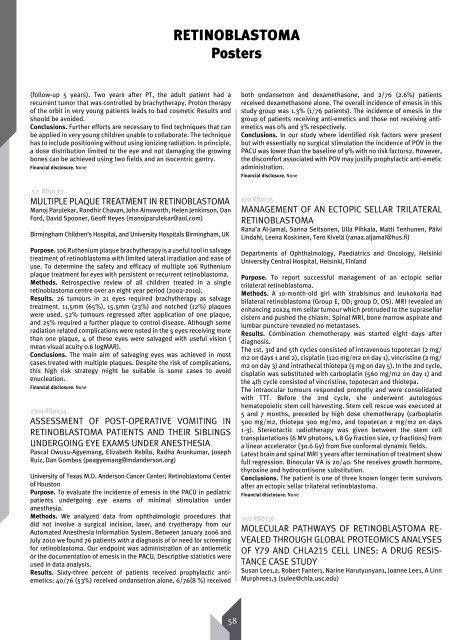Program Book
Program Book
Program Book
Create successful ePaper yourself
Turn your PDF publications into a flip-book with our unique Google optimized e-Paper software.
(follow-up 5 years). Two years after PT, the adult patient had a<br />
recurrent tumor that was controlled by brachytherapy. Proton therapy<br />
of the orbit in very young patients leads to bad cosmetic Results and<br />
should be avoided.<br />
Conclusions. Further efforts are necessary to find techniques that can<br />
be applied in very young children unable to collaborate. The technique<br />
has to include positioning without using ionizing radiation. In principle,<br />
a dose distribution limited to the eye and not damaging the growing<br />
bones can be achieved using two fields and an isocentric gantry.<br />
Financial disclosure. None<br />
52 RBp133<br />
MULTIPLE PLAQUE TREATMENT IN RETINOBLASTOMA<br />
Manoj Parulekar, Randhir Chavan, John Ainsworth, Helen Jenkinson, Dan<br />
Ford, David Spooner, Geoff Heyes (manojparulekar@aol.com)<br />
Birmingham Children’s Hospital, and University Hospitals Birmingham, UK<br />
Purpose. 106 Ruthenium plaque brachytherapy is a useful tool in salvage<br />
treatment of retinoblastoma with limited lateral irradiation and ease of<br />
use. To determine the safety and efficacy of multiple 106 Ruthenium<br />
plaque treatment for eyes with persistent or recurrent retinoblastoma.<br />
Methods. Retrospective review of all children treated in a single<br />
retinoblastoma centre over an eight year period (2002-2010).<br />
Results. 26 tumours in 21 eyes required brachytherapy as salvage<br />
treatment. 11.5mm (65%), 15.5mm (23%) and notched (12%) plaques<br />
were used. 52% tumours regressed after application of one plaque,<br />
and 25% required a further plaque to control disease. Although some<br />
radiation related complications were noted in the 5 eyes receiving more<br />
than one plaque, 4 of these eyes were salvaged with useful vision (<br />
mean visual acuity 0.6 logMAR).<br />
Conclusions. The main aim of salvaging eyes was achieved in most<br />
cases treated with multiple plaques. Despite the risk of complications,<br />
this high risk strategy might be suitable is some cases to avoid<br />
enucleation.<br />
Financial disclosure. None<br />
2301 RBp134<br />
ASSESSMENT OF POST-OPERATIVE VOMITING IN<br />
RETINOBLASTOMA PATIENTS AND THEIR SIBLINGS<br />
UNDERGOING EYE EXAMS UNDER ANESTHESIA<br />
Pascal Owusu-Agyemang, Elizabeth Rebllo, Radha Arunkumar, Joseph<br />
Ruiz, Dan Gombos (poagyemang@mdanderson.org)<br />
University of Texas M.D. Anderson Cancer Center; Retinoblastoma Center<br />
of Houston<br />
Purpose. To evaluate the incidence of emesis in the PACU in pediatric<br />
patients undergoing eye exams of minimal stimulation under<br />
anesthesia.<br />
Methods. We analyzed data from ophthalmologic procedures that<br />
did not involve a surgical incision, laser, and cryotherapy from our<br />
Automated Anesthesia Information System. Between January 2006 and<br />
July 2010 we found 76 patients with a diagnosis of or need for screening<br />
for retinoblastoma. Our endpoint was administration of an antiemetic<br />
or the documentation of emesis in the PACU. Descriptive statistics were<br />
used in data analysis.<br />
Results. Sixty-three percent of patients received prophylactic antiemetics:<br />
40/76 (53%) received ondansetron alone, 6/76(8 %) received<br />
RETINOBLASTOMA<br />
Posters<br />
58<br />
both ondansetron and dexamethasone, and 2/76 (2.6%) patients<br />
received dexamethasone alone. The overall incidence of emesis in this<br />
study group was 1.3% (1/76 patients). The incidence of emesis in the<br />
group of patients receiving anti-emetics and those not receiving antiemetics<br />
was 0% and 3% respectively.<br />
Conclusions. In our study where identified risk factors were present<br />
but with essentially no surgical stimulation the incidence of POV in the<br />
PACU was lower than the baseline of 9% with no risk factors2. However,<br />
the discomfort associated with POV may justify prophylactic anti-emetic<br />
administration.<br />
Financial disclosure. None<br />
120 RBp135<br />
MANAGEMENT OF AN ECTOPIC SELLAR TRILATERAL<br />
RETINOBLASTOMA<br />
Rana’a Al-Jamal, Sanna Seitsonen, Ulla Pihkala, Matti Tenhunen, Päivi<br />
Lindahl, Leena Koskinen, Tero Kivelä (ranaa.aljamal@hus.fi)<br />
Departments of Ophthalmology, Paediatrics and Oncology, Helsinki<br />
University Central Hospital, Helsinki, Finland<br />
Purpose. To report successful management of an ectopic sellar<br />
trilateral retinoblastoma.<br />
Methods. A 10-month-old girl with strabismus and leukokoria had<br />
bilateral retinoblastoma (Group E, OD; group D, OS). MRI revealed an<br />
enhancing 20x24 mm sellar tumour which protruded to the suprasellar<br />
cistern and pushed the chiasm. Spinal MRI, bone marrow aspirate and<br />
lumbar puncture revealed no metastases.<br />
Results. Combination chemotherapy was started eight days after<br />
diagnosis.<br />
The 1st, 3rd and 5th cycles consisted of intravenous topotecan (2 mg/<br />
m2 on days 1 and 2), cisplatin (120 mg/m2 on day 1), vincristine (2 mg/<br />
m2 on day 3) and intrathecal thiotepa (5 mg on day 5). In the 2nd cycle,<br />
cisplatin was substituted with carboplatin (560 mg/m2 on day 1) and<br />
the 4th cycle consisted of vincristine, topotecan and thiotepa.<br />
The intraocular tumours responded promptly and were consolidated<br />
with TTT. Before the 2nd cycle, she underwent autologous<br />
hematopoietic stem cell harvesting. Stem cell rescue was executed at<br />
5 and 7 months, preceded by high dose chemotherapy (carboplatin<br />
500 mg/m2, thiotepa 300 mg/m2, and topotecan 2 mg/m2 on days<br />
1-3). Stereotactic radiotherapy was given between the stem cell<br />
transplantations (6 MV photons, 1.8 Gy fraction size, 17 fractions) from<br />
a linear accelerator (30.6 Gy) from five conformal dynamic fields.<br />
Latest brain and spinal MRI 3 years after termination of treatment show<br />
full regression. Binocular VA is 20/40. She receives growth hormone,<br />
thyroxine and hydrocortisone substitution.<br />
Conclusions. The patient is one of three known longer term survivors<br />
after an ectopic sellar trilateral retinoblastoma.<br />
Financial disclosure. None<br />
350 RBp136<br />
MOLECULAR PATHWAYS OF RETINOBLASTOMA RE-<br />
VEALED THROUGH GLOBAL PROTEOMICS ANALYSES<br />
OF Y79 AND CHLA215 CELL LINES: A DRUG RESIS-<br />
TANCE CASE STUDY<br />
Susan Lee1,2, Robert Fanter1, Narine Harutyunyan1, Joanne Lee1, A Linn<br />
Murphree1,3 (sulee@chla.usc.edu)


